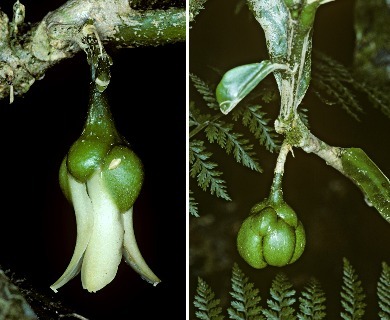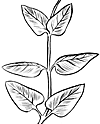Pilo Kea
Melicope spathulata
Rue Or Citrus family (Rutaceae)
Native species ()
This aromatic shrub or small tree has a strong odor of pepsin when crushed, paired often with very large oblong to leaves with dots visible under a lens, few large creamy white four-parted flowers at leaf bases, and four- capsules. To 40 ft (12 ) high and 8 inches (20 ) in trunk diameter, usually much smaller, 10–20 ft (3–6.1 ), with spreading branches leafy toward the end. Twigs stout, greenish when young, becoming pale gray and hairless, with large raised triangular leaf scars.

©2007 John Game
Flower clusters () at leaf bases, with mostly 3–5 short-stalked flowers at the end of stalks of about 1 inch (2.5 ). Flowers about 5⁄8–3⁄4 inch (15–19 ) long, not fragrant, composed of of four overlapping rounded green about 3⁄8 inch (10 ) long, four large spreading creamy white petals 5⁄8–3⁄4 inch (15–19 ) long, eight white united in tube of 1⁄2 inch (13 ), and with four- four-celled slender and four-grooved
(capsules) rounded, four- about 1 inch (25 ) in diameter, hairless, splitting into four parts, with at base. Seeds 5–8, elliptical, rounded, shiny black.
Wood dull whitish yellow and soft, subject to bluestain fungi and without growth rings.
Uncommon in wet forests at 2000–5000 ft (610–1524 ) altitude.
Special area
Kokee
Range
Kauai, Oahu, Maui, and Hawaii only
A few additional varieties and forms of this variable species have been named. This is confined to Hawaii and has three other species of shrubs. Stone wrote a monograph about the (1962).







